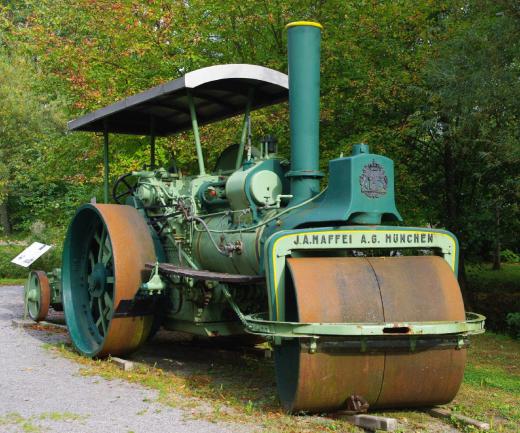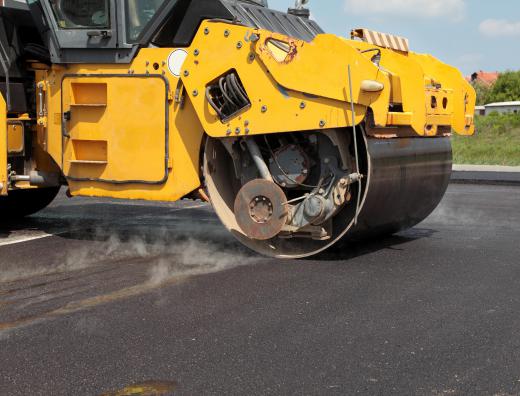The term “steam roller” (or “steamroller”) is typically used to refer to any sort of road rolling device, regardless of how it is powered. Road rollers are heavy construction equipment used to level and smooth surfaces such as airstrips and roads.
Today, it is very rare to see a road roller actually powered by a steam engine. Instead, most road rollers have internal combustion engines that run on fuels such diesel or, less commonly, gasoline or kerosene.
Some construction and industry museums have examples of antique steam rollers on display. Classic steam rollers can also be seen at steam festivals and fairs, having been preserved by enthusiasts.
History of Steam Rollers

The earliest road rollers were drawn by horses or pushed by hand. Just like modern road rollers, they relied on a heavy cylinder or drum that was rolled over the surface that needed to be compacted. However, the weight of the drum was limited by the strength of the people or animals pushing or pulling the roller. When the steam engine was developed during the Industrial Revolution, early 19th-century inventors and engineers began creating prototypes of road-rolling vehicles powered by steam.
In the late 1860s, the British company Aveling & Porter patented the steam roller and manufactured the first commercially-successful steam rollers, exporting it around the world and quickly replacing horse-drawn road rollers.
Steam Rollers and Traction Engines

Victorian-era steam rollers were very similar in design to traction engines (steam-powered tractors), except that steam rollers featured a heavy roller (or two adjacent rollers) in place of the front wheel and axle, while the back driving wheels of a steam roller were smooth, rather than treaded.
Some traction engines could be converted into steam rollers by replacing the treaded tires with smooth rollers, allowing them to alternate between hauling goods and smoothing road surfaces.
Use of Steam Rollers

By the mid-20th century, the steam roller had largely been replaced by the road roller, as internal combustion engines became robust enough to handle heavy work. In some countries, however, steam-powered rollers were still in use for road construction and maintenance into the 1960s and even 1970s.
The correct term for the diesel or gas-powered vehicles used today is “road roller,” because they are no longer steam powered. However, the steam roller is an iconic piece of equipment, and thus people often use the term generically to refer to any road-rolling device.
Modern Steam Rollers and Variations

The modern road roller is used to prepare roads and foundations at various stages of construction, as well as flat surfaces such as soil, concrete, and gravel. There are many different types of modern road rollers, with various designs to suit their intended function. Single drum, tandem drum, and pneumatic tyre rollers are the most common configurations, with the latter used to knead and seal road surfaces such as asphalt.

There is a huge amount of variation in the size and weight of road rollers. Some pedestrian-operated, walk-behind rollers weigh as little as 100 lbs (45 kg), while large ride-on rollers can weigh as much as 22 tons (20 tonnes). Road rollers are very slow-moving vehicles, with top speeds of around 6 mph (10 km/h).
Some of these vehicles use water or other lubricants to prevent hot asphalt and materials on the roadbed from sticking to the rollers. To make them even heavier, the drums of certain vehicles can be filled with water, as it is the weight that makes the machines effective levelers and compactors.
The heaviest road rollers are used for tasks such as landfill compaction, and can weigh up to 60 tons (54 tonnes). Also known as roller-compactors, these vehicles vibrate during operation to further compact the ground. Vibrating roller drums also allow smaller vehicles to carry out the compacting work of a heavier vehicle. Compactors often feature padfoot or sheepsfoot rollers, which have smaller surface areas and thus provide additional ground compression.
Did You Know?
- The new age neoclassical band Mannheim Steamroller got its name by combining “Mannheim roller” (a German music technique) and “steam roller.”
- The rock band Buffalo Springfield named themselves after a popular American steam roller manufacturer, the Buffalo-Springfield Roller Company.
- The word “steam roller” has entered common usage to describe a certain personality type. People with “steamroller personalities” use aggression to achieve what they want and dominate other individuals.
Steam rollers are one of the most iconic pieces of construction equipment you’ll find. These massive tools were first introduced for industrial use at the turn of the 20th century and they’ve become a staple of the construction industry since. In the time since its invention, the steam roller has become one of the most common types of heavy machinery found on a construction site. In the 100+ years since its introduction, this tool has evolved to become more mechanically advanced and it now rarely relies on a steam engine for power. Still, the name endures, and the word “steam roller” is used to describe most road rollers, regardless of whether or not they’re actually powered by steam.
How Steam Rollers Work
As the name suggests, steam rollers were initially powered by steam engines that provide propulsion to the machine. They were invented to level roads and compact surfaces. The steam engine worked by producing pressure that pushes a piston inside a cylinder back and forth. A rod and flywheel can then be used to power the wheels of the steam roller, allowing it to effectively flatten whatever surface it is used on.
Modern steam rollers are actually most commonly powered by diesel engines that are more efficient and powerful than steam engines. This efficiency allows diesel-powered steam rollers to be used for greater distances and perform harder work. This shift from steam power towards diesel power happened gradually but was generally complete by the late 1930s and early 1940s.
6 Different Types of Steam Rollers
1. Cylindrical roller: One of the most popular types of steam rollers is the simple cylindrical roller. This tool is lightweight, easy to use, and does not actually utilize steam power — or any type of power at all! Instead, the user walks behind it to propel it forward.
2. Grid roller: A grid roller is great if your project requires high contact pressure but minimal kneading. It’s best for coarse soil that has been well-graded or weathered rocks that need to be compacted. Steel bars on the roller create a grid-like pattern and give this steam roller its name.
3. Pneumatic roller: This type of steam roller is a ride-on machine that offers uniform pressure. It is most commonly used for asphalt and cold-laid bituminous surfaces, making it ideal for pavements or loose layers of soil. It’s also powered by pneumatic pressure, which is affordable and efficient.
4. Sheepsfoot roller: A sheepsfoot roller is remarkably versatile and useful for a wide range of applications. This is because the weight of the drum can be adjusted by ballasting, which makes it more efficient when compacting. It is best used in conjunction with materials such as soil and clay that is either wet or silty.
5. Smooth wheeled roller: If your project requires a steam roller that can pave or flatten a large swath of surface quickly, a smooth wheeled roller is likely your best bet. This type of roller — also often called a static roller — is useful for use with large surfaces such as asphalt. It’s also ideal for graded surfaces.
6. Vibratory roller: As the name suggests, this type of steam roller incorporates vibration to achieve a deep compacting effect. This makes it ideal for use with asphalt, crushed rock, gravel, or concrete. The machine’s vibration can help ensure the structural integrity of its surface.
How to Use a Steam Roller
Using a steam roller is simple. If you’re using a smaller, walk-behind roller for a DIY project at home, it can easily be operated by simply turning it on and pushing the machine forward. Larger, industrial-grade steam rollers are bigger but also simple to operate. These are typically referred to as “ride-on” rollers because the user rides the machine as it moves forward. To use one of these steam rollers, the user must enter the cab of the machine and power on the equipment.It can then be steered forward.
It is important that any person operating heavy machinery have the proper training and certification to do so. Many construction companies require that steam roller operators have previous experience, and in some cases, a special type of commercial license is required. Some companies also offer certification courses that train students in the proper use of steam roller machinery. Training to operate a steam roller can open up an array of career opportunities for construction workers. It’s also an essential investment in crew safety to ensure that all heavy machinery operators are professionally trained and credentialed.
